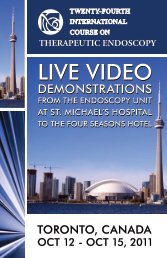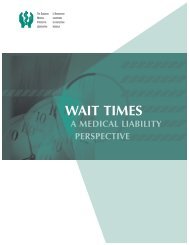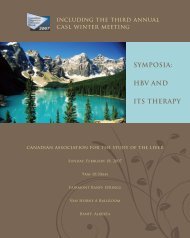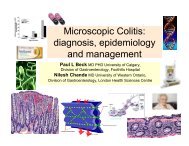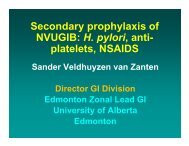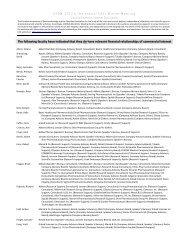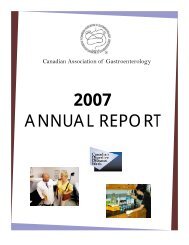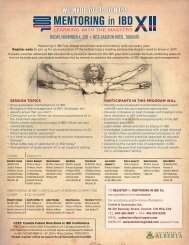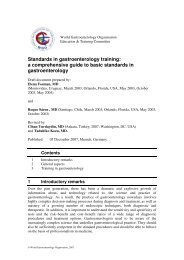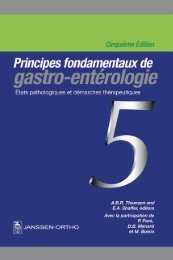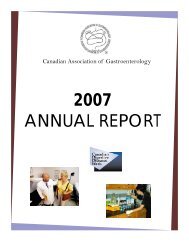Manifestations of Gastrointestinal Disease in the Child
Manifestations of Gastrointestinal Disease in the Child
Manifestations of Gastrointestinal Disease in the Child
You also want an ePaper? Increase the reach of your titles
YUMPU automatically turns print PDFs into web optimized ePapers that Google loves.
730 FIRST PRINCIPLES OF GASTROENTEROLOGY<br />
greater than 17 micromolar if <strong>the</strong> total bilirub<strong>in</strong> is less than 85 micromolar<br />
and should be no more than 20% <strong>of</strong> <strong>the</strong> total bilirub<strong>in</strong> when it is greater than<br />
85 micromolar.<br />
The North American Society for Pediatric Gastroenterology, Hepatology<br />
and Nutrition (NASPGHAN) recommends measur<strong>in</strong>g total and direct (conjugated)<br />
serum bilirub<strong>in</strong> <strong>in</strong> any <strong>in</strong>fant jaundiced at two weeks <strong>of</strong> age. Healthy<br />
breast-fed <strong>in</strong>fants with a normal history (no dark ur<strong>in</strong>e or pale stool) could be<br />
asked to return at three weeks <strong>of</strong> age for <strong>the</strong> blood test.<br />
Cholestastic jaundice is uncommon, occurr<strong>in</strong>g <strong>in</strong> one <strong>in</strong> 2,500 <strong>in</strong>fants. The<br />
more common causes <strong>of</strong> neonatal cholestasis are outl<strong>in</strong>ed <strong>in</strong> Table 13.<br />
The most common causes <strong>of</strong> neonatal cholestasis are biliary atresia and<br />
<strong>the</strong> multifactorial cholestasis seen <strong>in</strong> premature <strong>in</strong>fants. However, <strong>the</strong>re is<br />
such a wide differential diagnosis, a structured approach to <strong>in</strong>vestigation is<br />
essential. It is imperative to first recognize conditions need<strong>in</strong>g immediate<br />
treatment and any o<strong>the</strong>r treatable causes <strong>of</strong> cholestasis. Early detection and<br />
accurate diagnosis <strong>of</strong> biliary atresia are also very important because <strong>in</strong>fants<br />
who have biliary dra<strong>in</strong>age surgery performed by 45-60 days <strong>of</strong> age have <strong>the</strong><br />
best outcome.<br />
7.3.2.2 Biliary atresia<br />
This condition occurs with a frequency variously reported to be between<br />
1:8,000 and 1:21,000 live births. It is <strong>the</strong> most common cause for children<br />
requir<strong>in</strong>g liver transplantation. In biliary atresia, all or part <strong>of</strong> <strong>the</strong> extrahepatic<br />
biliary ducts is obliterated lead<strong>in</strong>g to complete obstruction <strong>of</strong> bile flow. The<br />
etiology <strong>of</strong> biliary atresia is unknown and it is likely that it is a condition<br />
with multiple etiologies. Typically, jaundice is noticed between three to<br />
six weeks <strong>of</strong> age <strong>in</strong> an o<strong>the</strong>rwise healthy baby. Light-colored stools may<br />
have been evident from birth and on exam<strong>in</strong>ation hepatomegaly is evident.<br />
Approximately 10-15% <strong>of</strong> babies have o<strong>the</strong>r congenital abnormalities which<br />
<strong>in</strong>clude polysplenia, malrotation, preduodenal portal ve<strong>in</strong> and a number <strong>of</strong><br />
cardiovascular abnormalities.<br />
The diagnosis <strong>in</strong>volves <strong>the</strong> exclusion <strong>of</strong> o<strong>the</strong>r known causes <strong>of</strong> neonatal<br />
cholestasis. Hepatobiliary scann<strong>in</strong>g shows no excretion <strong>of</strong> <strong>the</strong> isotope <strong>in</strong>to <strong>the</strong><br />
<strong>in</strong>test<strong>in</strong>e. Although this test has 100% sensitivity for biliary atresia it has only<br />
60% specificity. The isotope is also not excreted <strong>in</strong> many babies with severe<br />
<strong>in</strong>trahepatic cholestasis, particularly <strong>in</strong> those conditions where <strong>the</strong>re is a<br />
paucity <strong>of</strong> <strong>in</strong>trahepatic bile ducts.<br />
The liver biopsy f<strong>in</strong>d<strong>in</strong>gs are classically those <strong>of</strong> extrahepatic biliary<br />
obstruction with bile duct proliferation, bile duct plugs and expansion <strong>of</strong> <strong>the</strong><br />
portal tracts. When <strong>the</strong> biopsy f<strong>in</strong>d<strong>in</strong>gs are consistent with biliary atresia <strong>the</strong><br />
diagnosis is confirmed at laparotomy and with <strong>in</strong>traoperative cholangiogram.



